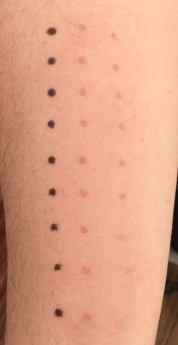The whitening, or ‘frosting’, that we often see in laser tattoo removal treatments is often described as ‘steam bubble formation on the surface of ink particles’.
While this is true, it is not the entire truth…
When ink particles absorb laser energy their surfaces become very hot (potentially thousands of degrees C).
All these ink particles are encapsulated within cells such as macrophages or fibroblasts. This means that the ink particles are surrounded by tissue water.
Consequently, the tissue water rapidly forms steam, which causes the cells to ‘explode’ and the ink particles/aggregates to fly apart, at high speed. I wrote an article on this a few years ago.
This is the essence of laser tattoo removal.
However, the melanocytes and melanosomes in the epidermis will also absorb some laser energy – especially the 532, 694 and 755 nm wavelengths, where melanin absorption is quite strong.
So, much of the frosting we see may actually be due to these epidermal cells ballooning due to rapid temperature rises in the melanin. This was first observed by one of my colleagues, PJ McLeod, in the original clinical studies in Canniesburn Hospital, Glasgow in 1982.
It can easily be demonstrated by firing laser pulses at non-tattooed skin which contains some melanin.
Obviously, darker skins will react more to the laser energy compared with lighter skins. Likewise, tanned skins (real or fake) will also react, which is why it is always better to wait until the tans have faded.
Here is a video of my wife’s skin (no tattoos) reacting to the 532nm wavelength from a QS Nd:YAG laser. it is clear that ‘frosting’ occurs, even though there are no tattoo ink particles. This frosting is entirely due to the melaninocytes and melanosomes in the epidermis reacting to the laser energy, which is strongly absorbed at 532nm. Note that there is a faint cracking sound when the laser interacts with the skin – but that there is NO tattoo ink!
We saw very similar reactions with the 694nm of the QS ruby laser back in the 1980s. Likewise with the Alexandrite’s 755nm wavelength.
The photo to the right shows a patch of very pale skin subjected to the same 532nm parameters as above – note that this results in a little frosting. This is significantly less than the tanned skin above because there is much less melanin in this patch of skin (on the same arm of the same wife!!)
Often, the frosting appears only in the first few treatments. When tackling deeper ink, the frosting is not so obvious. It is still there, but by the time the light has emerged form the deeper dermis, it has been scattered so many times that it has lost its original information (the ‘frosting’ information).
24 hours later…

The above two photos show the results of the above 532nm shots after 24 hours. There is some very mild erythema due to some of the capillaries being ruptured by this wavelength.
In summary, frosting occurs on both ink particles and melanocytes/melanosomes in the epidermis. It is more apparent in darker skins. Plus, it occurs more frequently with the lower wavelengths due to higher melanin absorption.
I should also point out that the 532nm is strongly absorbed in blood too! This can lead to damage in the superficial capillaries. I wrote a Research Letter about this phenomenon too.
Find our YouTube channel here.
Hope you enjoy these,
Mike.







Should frosting always be present in the first couple of treatments? I’ve just bought a Lynton Luminette Q and frosting not happening for me.
Wow. That is interesting. I just had my first session done to remove a racist tattoo. http://dontwantyourcivilwar.com/2021/09/20/tattoo-removal/
This is a good read thank you! I wanted to ask about erythema post 532 laser for tattoo removal. Will it possibly heal without scarring? How long does it usually take?
Hi Elle,
Erythema after laser treatment is perfectly normal, and usually a good sign. You will not scar if the correct fluence has been applied, even with 532nm light.
I’m not sure what your last question means – how long does what usually take?
Mike.